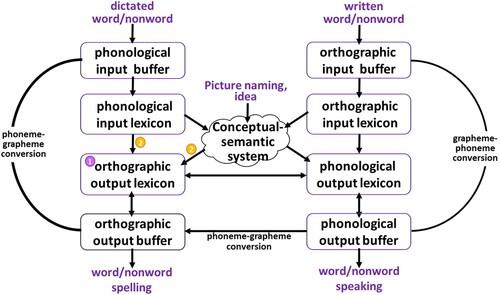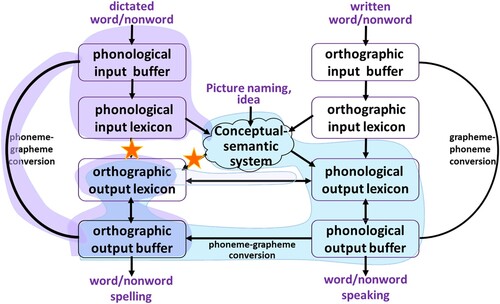Figures & data
Figure 1. The single word spelling model (presented within a broader lexical model also for naming and reading). 
 represents the loci of impairment in disconnection surface dysgraphia
represents the loci of impairment in disconnection surface dysgraphia
Table 1. Background description of the participants.
Table 2. Writing 404 words to dictation: % correct and number of errors of each type.
Table 3. Writing from semantics (sentence completion and written naming) and writing to dictation of the same 50 unpredictable words: % words written with surface dysgraphia errors.
Table 4. The lexicality of surface error (out of the total words with a potential for both lexical and nonlexical surface response) and a comparison between surface errors in spelling words with and without a lexical potential for surface error.
Table 5. Number of surface errors in writing the same 50 words with and without visual feedback.
Figure 2. Two possibilities for the locus of disconnections in disconnection surface dysgraphia. (a) disconnection only from the semantic system to the orthographic output lexicon (OOL), (b) disconnections from the phonological input lexicon (PIL) and from the semantic system to the OOL. In dictation, lexical contribution in (a) is expected through PIL-OOL connection, and in (b) through a feedback between the OOL and the orthographic output buffer, supporting input from the sublexical route.

Table 6. Percentage of words spelled with surface dysgraphia errors in writing potentiophones to dictation and in writing homophones and potentiophones from semantics in the disconnection surface dysgraphia participants, in comparison to age-matched controls.
Figure 3. Our conclusion regarding the locus of deficit of the participants with disconnection surface dysgraphia: a double disconnection of the orthographic output lexicon from the phonological input lexicon and from the semantic system (marked by stars), spelling sublexically with lexical support through feedback from the orthographic output lexicon.

Figure 4. (a) A shared orthographic lexicon (b) Separate orthographic input lexicon and orthographic output lexicon.

Table 7. Tests that assess the orthographic lexicon in reading: Number of surface errors in reading aloud (of 196 words) and % correct (and number of errors) on the lexical decision, homophone word-association and homophone-potentiophone picture-word matching tasks.
